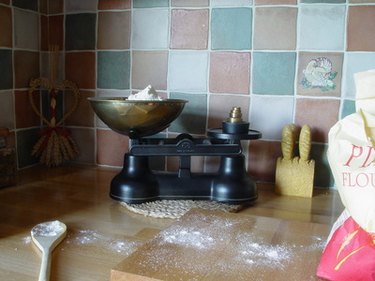Things You'll Need
All-purpose flour
Baking soda
Cream of tartar
Bowls
Spoon
Salt
Sifter
Small jar

Some recipes require self-rising flour. Not all kitchens have this on hand. In a perfect world, we plan ahead and have all the ingredients or at least have time to shop for them. Unfortunately, the modern world limits time and good planning. Ironically, self-rising flour should save us time. It contains raising agents such as baking powder that we would otherwise have to measure and put in separately. However, if your kitchen does not have self-rising flour or baking powder, adding baking soda can do the trick.
Self-Rising Flour for a Recipe
Step 1
Place the required amount of flour in a bowl.
Video of the Day
Step 2
For each cup of flour, add 1 tsp. of cream of tartar and 1/2 tsp. of baking soda. Mix well.
Step 3
Add the flour mixture to a sifter and sift together three to four times into a mixing bowl.
Self-Rising Flour for Future Use
Step 1
Mix together 6 tsp. of baking soda and 8 tsp. of cream of tartar in a bowl.
Step 2
Place in an air-tight jar and shake to mix thoroughly. Use as a replacement for baking powder.
Step 3
When you are ready to use the mixture, place 6 cups of flour, 1 tbsp. of salt and 3 tbsp. of the baking soda/cream of tartar mixture in a bowl and stir to combine.
Step 4
Place the flour mixture in a sifter and sift together three to four times and proceed with your recipe.
Tip
Baking powder cannot substitute for baking soda without changing the recipe to reduce acidic ingredients.
Warning
Measurement are approximate. For example, According to Mamta's Kitchen, increases in the fat content of a recipe, together with more eggs, would require less baking soda.
Video of the Day